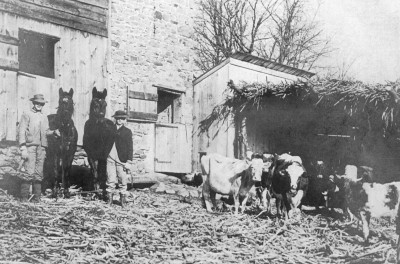It seems as though our grandparents and great-grandparents were overall much healthier, despite having lived off of a diet high in fat, meat and carbs. There is a lot of debate and varying opinions about why past generations seemed healthier. Regardless of what you believe, you can’t deny that diet is a major factor in health.
Here are 5 foods that were common on the dinner plate that you may want to add to your diet.
1. Homemade butter
If you’ve never had homemade butter, you’re really missing out. Butter made from grass-fed raw milk is absolutely delicious and loaded with nutrients to boot. Fat is nothing to fear when it’s from a source like this.
The benefits of homemade butter are numerous, including:
- Is a high source of easily absorbable vitamin A.
- Is loaded with antioxidants which protect against free radicals and fortify arteries.
- Is rich in vitamins E, K and D.
- Helps reduce stiffness in those with arthritis.
- Helps keep the brain and nervous system performing well.
- Helps protects and heals gastrointestinal infections.
Making homemade butter isn’t difficult and you don’t need a churn. All you will need is milk, a little salt and either a mixer or a simple jar.
Story continues below video
2. Organs
In past generations organs were certainly not wasted and often relished as a tasty, nutritious meal. Even though not everyone is a fan, it is well-worth it to add them to your diet every now and then.
Make ‘Off-The-Grid’ Super Foods Just Like Grandma Made!
Some of the best types of organs include:
- Heart (beef, lamb and chicken) – technically a muscle.
- Liver (beef).
- Brain (any).
- Kidney (beef).
Other options are tripe and tongue.
Organs tend to be an acquired taste, and generally beef organs are a little milder compared to lamb, mutton, pig, etc. Organs are loaded with vitamins, minerals, fats and amino acids. Liver is particularly nutritionally powerful and actually has the highest amount of vitamin A of any foods. An added bonus of these organs is how inexpensive they tend to be.
3. Bone broth
 Bone broth or bone stock is another food item that many people pass up, instead buying a premade stock from the grocery store. This is a real shame, since homemade bone broth isn’t just more delicious but also very healthy. Plus, it reduces waste by using up those leftover beef or chicken bones.
Bone broth or bone stock is another food item that many people pass up, instead buying a premade stock from the grocery store. This is a real shame, since homemade bone broth isn’t just more delicious but also very healthy. Plus, it reduces waste by using up those leftover beef or chicken bones.
Bone broth can be made from really any bones, even fish (which is quite popular in Asian cuisine). This protein-packed elixir is loaded with vitamins and minerals. Even studies have proven that chicken bone broth truly does help get rid of a cold! Read this article to learn how to make it.
You can use your bone broth in a soup or simply drink a mug of it.
4 Fermented foods
While some cultures still eat a lot of fermented foods, most Americans don’t — save perhaps for pickles. Since most people don’t rely on canning to preserve their foods, the use of fermentation isn’t really common. For past generations, fermentation was used more often to increase the longevity of food. The fermentation process also gives different nutrition.
Some of the most common fermented foods include:
- Sauerkraut
- Pickles
- Pickled vegetables
- Kimchi
- Salsa
While some of the above fermented foods are from different cultures, they are still a healthy food you can enjoy. Properly fermented foods are filled with vitamins, minerals and probiotics. These will, of course, vary depending on the vegetables you use. There are also different methods for fermenting produce.
Identity Theft Claims A New Victim Every 2 Seconds. Learn How To Protect Yourself!
Some recipes require a brine, like pickles, while other foods, such as sauerkraut, can be lacto-fermented. Lacto-fermentation simply uses salt and spices, along with water. Some sauerkraut and kimchi recipes use no water. Instead, the salt naturally pulls moisture from the produce.
You can find tons of at-home pickle and other fermented food recipes online. I highly recommend you give them a try. Aside from health benefits, it is also a great way to ensure you don’t waste extra produce from your garden.
5. Wild game
Hunting is still a popular hobby in many parts of the US, but it’s safe to say that most of our grandparents or great-grandparents ate wild game much more often. Wild game, both large and small, offer health benefits that many normal meats from livestock don’t.
As a whole, wild game is far leaner than beef, pork or lamb. The meat is also believed to be nutritionally superior, because the animals ate what they were supposed to eat. Rather than consuming grains and hay, deer and elk eat a variety of fresh foods. Compared to most commercial livestock, meat from wild game is much higher in omega-3 fatty acids.
As mentioned before, it isn’t just big game like deer, elk or antelope that is good for us. Don’t forget about small game like rabbits and even squirrel. If you live in a rural area but don’t hunt, ask your neighbors or friends that do hunt if you could buy off a portion of their deer or other animal from them. Most wild game takes a little getting used to for some people, while others find that they taste delicious. It is definitely worth a try!
Please share your favorite meals and/or recipes your grandparents may have passed down to you in the comment section below!
Harness The Power Of Nature’s Most Remarkable Healer: Vinegar
 Off The Grid News Better Ideas For Off The Grid Living
Off The Grid News Better Ideas For Off The Grid Living




